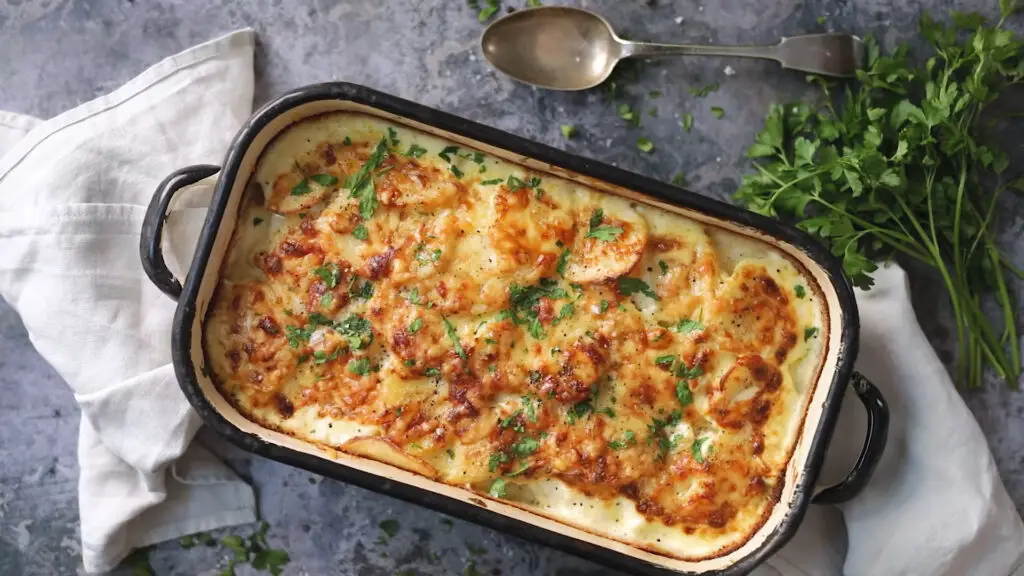
Are you looking for a show-stopping side dish to accompany your roast dinner? Look no further than the classic French creation of Dauphinoise Potatoes.
This mouthwatering dish, with its creamy texture and delightful flavors, is sure to impress your family and guests. In this blog, we will guide you through the steps of creating this masterpiece of simplicity and taste.
📝 Recipe
Before we dive into the recipe, let’s gather all the ingredients you will need:
- 2 cups of double or heavy cream (480ml)
- 2 cups of full-fat milk (480ml)
- 3 garlic cloves
- 1.25kg (2.75 pounds) of floury white potatoes (Maris Piper recommended)
- 1/2 teaspoon of salt
- 1/2 teaspoon of black pepper
- 1/4 teaspoon of white pepper
- A pinch of nutmeg
- 100g (1 cup) of grated Gruyere cheese
👩🍳 Instructions
Let’s get started on this delectable dish:
1. Preparing the Potatoes
Preheat your oven to 190°C (375°F) and lightly grease a 32 by 18 centimeter oven-proof dish. In a large saucepan, combine the double cream, full-fat milk, and peeled, lightly squashed garlic cloves. Bring the mixture to a boil, then reduce the heat.
While the mixture is heating, proceed to peel the potatoes. Use a mandolin or the slicing attachment on your food processor to thinly slice the potatoes to a thickness of approximately three to four millimeters.
2. Cooking the Potatoes
Add the sliced potatoes to the saucepan with the cream and milk mixture. Stir gently to ensure the potatoes are evenly coated. Bring the mixture back to a boil, then reduce the heat to a simmer. Cook the potatoes for six to seven minutes, stirring occasionally, until they are tender and just cooked.
Be careful not to let the potatoes catch on the bottom of the pan. Keep an eye on them to avoid any burning or sticking.
3. Seasoning and Layering
While the potatoes are simmering, prepare the seasoning mixture. In a separate bowl, combine the salt, black pepper, white pepper, and nutmeg.
Once the potatoes are tender, use a slotted spoon to remove about half of them from the saucepan. Arrange the potato slices in the greased baking dish, ensuring that there is sauce between each layer of potato. Use a knife to separate any slices that stick together.
Sprinkle half of the seasoning mixture and half a cup of grated Gruyere cheese over the first layer of potatoes. Then, spoon the remaining potatoes into the dish and pour enough sauce over them to coat them well. Sprinkle the remaining seasoning mixture and another cup of grated Gruyere cheese on top.
4. Baking the Dish
Place the baking dish in the preheated oven and bake for 40 to 45 minutes, or until the cheese turns golden and bubbly.
Once the dish is ready, remove it from the oven and let it cool for a few minutes. Serve the creamy Dauphinoise Potatoes alongside your roast dinner, and watch as your guests’ taste buds dance with delight.
🍽️ Conclusion

Dauphinoise Potatoes are a true culinary gem, offering a harmonious balance between simplicity and elegance. With just a few ingredients and minimal effort, you can create a dish that will leave everyone impressed.
The creamy texture, combined with the subtle flavors of garlic, nutmeg, and Gruyere cheese, make this side dish a perfect companion for any roast dinner.
So why not take some time to perfect your knife skills and thinly slice those potatoes? Treat yourself and your loved ones to the delightful experience of savoring these beautifully crafted Dauphinoise Potatoes, inspired by the legendary Delia Smith. Bon appétit!
FAQs
Can you prepare this dish in advance?
Yes, you can prepare this dish ahead of time! You can prepare the Dauphinoise Potatoes up to the point of baking. Once you have layered the potatoes in the baking dish and added the seasoning and cheese, cover the dish tightly with foil or plastic wrap and refrigerate it.
When you’re ready to serve, simply remove the dish from the refrigerator, let it sit at room temperature for about 30 minutes, then bake it according to the recipe instructions. This make-ahead option can be a great time-saver for busy cooks or for preparing dishes in advance for a special occasion.
Can I add cheese to this recipe?
Yes, you can add cheese to this recipe! The recipe already incorporates 100g (1 cup) of grated Gruyere cheese, sprinkling it over the potato layers before baking. If you’d like a cheesier dish, you can increase the amount of cheese or try adding different types of cheese to suit your taste.
Some popular options include Parmesan, cheddar, or Emmental. Just sprinkle the additional cheese over the layers of potatoes before baking, and enjoy the extra cheesiness in your Dauphinoise Potatoes!
How thin should the potato slices be?
Slice the potato slices thinly to a thickness of about three to four millimeters. Using a mandolin or the slicing attachment on your food processor can help you achieve uniform slices.
Thin slices are key to ensuring that the potatoes cook evenly and absorb the creamy sauce, resulting in a deliciously creamy and tender dish.
What are the benefits of eating dauphinoise potatoes?
While Dauphinoise potatoes are delicious, they are also relatively high in calories and fat due to the cream and cheese. Consume them in moderation as part of a balanced diet.
Is it necessary to use a mandoline slicer for the potatoes?
It’s not necessary to use a mandoline slicer for the potatoes, but it can be helpful for achieving evenly sliced potatoes, which is important for even cooking.
If you don’t have a mandoline, you can use a sharp knife to thinly slice the potatoes, aiming for slices that are about three to four millimeters thick. Just take your time and try to make the slices as uniform as possible so they cook evenly.
How do I make dauphinoise potatoes crispy on top?
Remember, achieving the perfect level of crispiness may require some experimentation based on your oven and personal preference, so feel free to adjust the cooking time and temperature to suit your taste.

